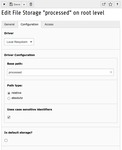Planet PHP
Guest
Warming the page cache after a production deployment took up to two minutes for certain TYPO3 pages. We got that down to mere seconds by not throwing away scaled and cropped images.
Cache cleaning
At work we use docker for our TYPO3 projects. Deploying changes to the live system only requires us to push into the main extension's master branch, and Jenkins will do the rest: Build the web server image with all the PHP code, pull that onto the production server, start up the new container, clear the cache and stop the old container.
Because potentially everything could have changed code-wise during deployments, we need to clear all the TYPO3 caches. Apart from the database cache tables, all files in typo3temp/ are pruned during deployment.
Responsive sites & focuspoint
Our TYPO3 projects have a responsive layout - it can be viewed in any resolution, and it will look good. Different resolutions and screen aspect ratios often need different images sizes and ratios - and those images need to be generated automatically.
To make sure that the important part of a picture is kept regardless of the targeted width-height-ratio, we utilize the focuspoint extension. Editors select the important part of the picture within the TYPO3 backend, and this part will be kept during image cropping.

Mix that with different image resolutions for normal and high-density displays, and we're up to 6 images that need to be generated for a single image on the website (2 aspect ratios + 2 resolutions each).
When clearing typo3temp/, all those cropped and scaled images are thrown away and need to be regenerated. Calling pages with many images needed up to two minutes until they had all their images regenerated, which was just too much.
Processed files folder
Our goal was to keep the processed files. Their file names are a hash of the image processing configuration options, so they are stable over time. Cleaning caches has no effect on them.
Information about generated files are stored in the database as well, in table sys_file_processedfile. Since the database is kept during deployments, the contents of this table are also stable.
When re-using a production database dump on the test or dev system, TYPO3 notices if files have an entry in the processed files table but are missing on disk, and recreates them.
Solution
focuspoint saved the cropped files into typo3temp/focuscrop which was thrown away on deployments, so we made a patch to make that configurable.
With that in place we created a new folder in the site's document root, processed. It was "mounted" into TYPO3 with a new file storage record (uid: 2) that has its base path set to processed/ (path type "relative").


The focuspoint extension was configured to store its generated files into processed/focuspoint
File storage fileadmin (auto-generated) was configured to store its "manipulated and temporary images" into
Truncated by Planet PHP, read more at the original (another 1283 bytes)
Читать дальше...
Cache cleaning
At work we use docker for our TYPO3 projects. Deploying changes to the live system only requires us to push into the main extension's master branch, and Jenkins will do the rest: Build the web server image with all the PHP code, pull that onto the production server, start up the new container, clear the cache and stop the old container.
Because potentially everything could have changed code-wise during deployments, we need to clear all the TYPO3 caches. Apart from the database cache tables, all files in typo3temp/ are pruned during deployment.
Responsive sites & focuspoint
Our TYPO3 projects have a responsive layout - it can be viewed in any resolution, and it will look good. Different resolutions and screen aspect ratios often need different images sizes and ratios - and those images need to be generated automatically.
To make sure that the important part of a picture is kept regardless of the targeted width-height-ratio, we utilize the focuspoint extension. Editors select the important part of the picture within the TYPO3 backend, and this part will be kept during image cropping.

Mix that with different image resolutions for normal and high-density displays, and we're up to 6 images that need to be generated for a single image on the website (2 aspect ratios + 2 resolutions each).
When clearing typo3temp/, all those cropped and scaled images are thrown away and need to be regenerated. Calling pages with many images needed up to two minutes until they had all their images regenerated, which was just too much.
Processed files folder
Our goal was to keep the processed files. Their file names are a hash of the image processing configuration options, so they are stable over time. Cleaning caches has no effect on them.
Information about generated files are stored in the database as well, in table sys_file_processedfile. Since the database is kept during deployments, the contents of this table are also stable.
When re-using a production database dump on the test or dev system, TYPO3 notices if files have an entry in the processed files table but are missing on disk, and recreates them.
Solution
focuspoint saved the cropped files into typo3temp/focuscrop which was thrown away on deployments, so we made a patch to make that configurable.
With that in place we created a new folder in the site's document root, processed. It was "mounted" into TYPO3 with a new file storage record (uid: 2) that has its base path set to processed/ (path type "relative").


The focuspoint extension was configured to store its generated files into processed/focuspoint
File storage fileadmin (auto-generated) was configured to store its "manipulated and temporary images" into
Truncated by Planet PHP, read more at the original (another 1283 bytes)
Читать дальше...

